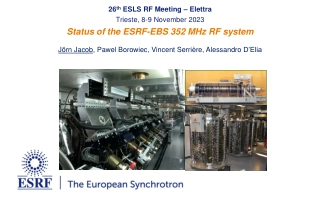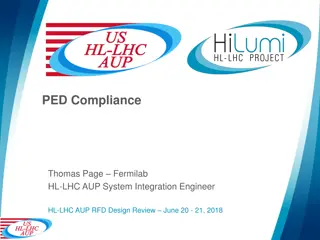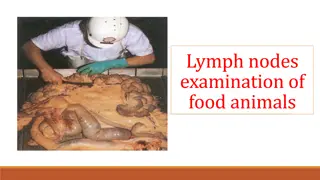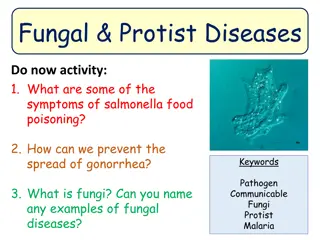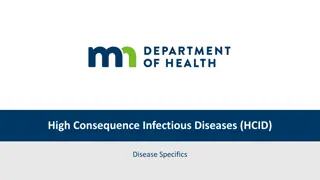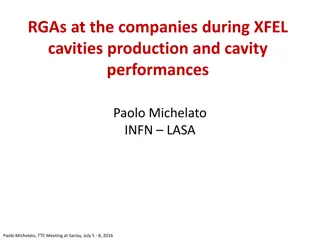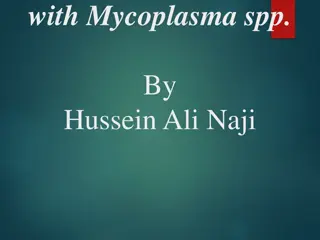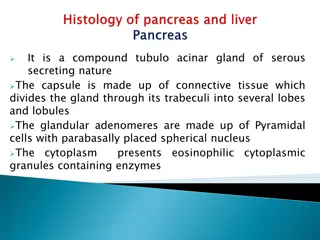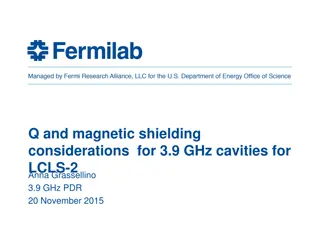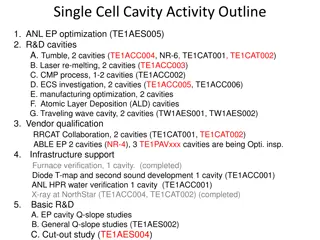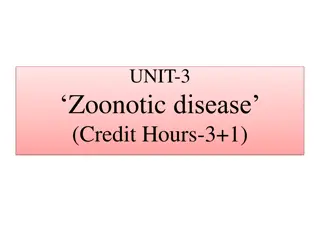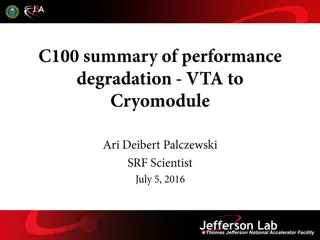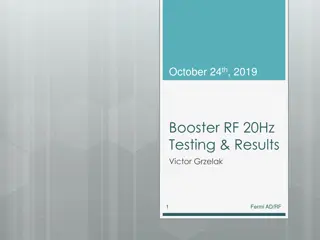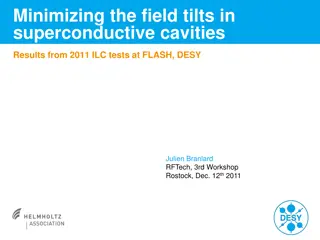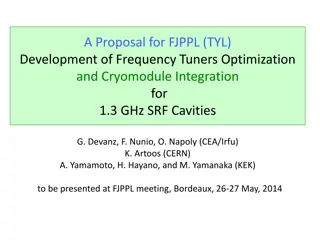Purulent Diseases of Serous Cavities: Understanding Purulent Pleurisy and Empyema Pleurae
Purulent diseases of serous cavities, specifically purulent pleurisy and empyema pleurae, are marked by the secondary nature of inflammation in the parietal and visceral pleura. The classification details the etiology and clinical variations, while the pathogenesis explains the development from various infections. The clinical presentation includes symptoms like cough, dyspnea, elevated body temperature, and findings on examination such as restricted thoracic excursion and diminished breath sounds. Radiological and laboratory investigations play a crucial role in diagnosing these conditions.
Download Presentation

Please find below an Image/Link to download the presentation.
The content on the website is provided AS IS for your information and personal use only. It may not be sold, licensed, or shared on other websites without obtaining consent from the author. Download presentation by click this link. If you encounter any issues during the download, it is possible that the publisher has removed the file from their server.
E N D
Presentation Transcript
Purulent diseases of serous cavities
Purulentpleurisy,empyemapleurae - purulent inflammation of a parietal and visceral pleura In most cases is a secondary disease.
Classification: Etiology: -Streptococcal -Pneumococcal -Staphylococcal -Mixed On an arrangement pus: The free: Total Average Small The encapsulated: On character of exudate: The purulent The putrefactive The purulent - putrefactive Pyopneumothorax Haemopyothorax On a clinical current: The acute The chronic The multichamber The single- chamber Basal Parietal Midlevel Apical
Patogenez: Acute purulent pleurisy is complication of abscess of a lung, pleuropneumonia, influenzal pneumonia, gangrenes of a lung, the wounds getting into a pleura. Develops at infection of a parasitic or congenital cyst, disintegration of a malignant tumour, break of a tubercularcavity in a pleural cavity etc. Infection lymphogenous way from the infection centres. of a pleura can occur a hematogenous or The weakly virulent flora causes formation of a small fibrinogenous exudate that promotes formation of solderings (dry pleurisy). More virulent microbes cause an active exudation- exudative pleurisy which can gain purulent character.
Patogenez: The inflammation begins with a hyperemia, hypostasis, an ekssudation, dot hemorrhage, fibrin adjournment. Pleura infiltrating the leukocytes forming pus. At the bottom of a pleural cavity pus dense, with granulated masses, in more blankets liquid. In the most top layer transparent exudate. Upon transition of process to a productive phase solderings, adhesions, bringing to an encysted empyemaare formed.
Clinic: Stitch, heavy feeling. The cough, the complicated breath, short wind. Body temperature increase (39-400 ), tachycardia (120-130 in mines), weakness. Restriction of excursion of a thorax, backlog of the sick party from the healthy. At an exudate congestion a thorax bulging in back-lower departments, intercostal intervals are maleficiated. Voice trembling isweakened or is not carried out. Ata perkussion sound shortening overexudate. Ata considerable congestion of exudate Demuazo's line, Garlend and Grokko-Raukhfusa's triangles. Mediastinum shift in the healthy party. Auskultation considerable easing or total absence of respiratory noise overexudate. In blood: leukocytosis, shiftof a leukocytic formula to the left, increase in erythrocyte sedimentation rate Roentgenogram: a liquid congestion in a pleural cavity.
Patients purulent pleurisy complain of pain in his side, coughing, feeling of heaviness or fullness in the side, shortness of breath, inability to take a deep breath, shortness of breath, fever, weakness. Pain in the chest is more pronounced at the beginning of the disease, is an itchy in nature, and as the spread of inflammation and accumulation of exudate weakened, joins a feeling of heaviness or fullness in the side. Gradually increasing shortness of breath. Cough, usually dry, and when the secondary pleurisy on the grounds of pneumonia or lung abscess - with sputum mucoid or purulent character, sometimes with copious amounts of purulent sputum.
Pleurisy. Lateral projection
Pleuralshock Abscess accompanied by pleural shock. It is preceded by painful cough which comes to the end with a sharp stitch ( blow with a dagger ). Skin pale, is covered cold then. Pulse frequent, weak filling, the AP it is lowered. Breath superficial, frequent, accrues short wind. Acrocyanosis. break in a pleural cavity is
Schemeofapunctureofapleuralcavity andpossiblecomplications A the needle has passed in a pleura cavity over an exudate B the needle has passed in soldering between pleura leaves C the needle has passed over an exudate in a lung tissues D the needle is passed through the lower part of the rib-diaphragmatic sinus in the abdominal cavity
Treatment Therapy of purulent pleurisy involves removal of pus, infection control, detoxification therapy, restoration of disturbed functions of the organs. Rapid elimination of purulent inflammation in the pleura and light smoothing is achieved the main goal of treatment is to contact the parietal and visceral pleura and their fusion. Coming obliteration purulent cavity leads to recovery of the patient. The earlier you start the treatment of empyema, the better the outcome, because spasams light still do not have time to undergo irreversible changes, and in the inflamed pleura has not formed a dense fibrous tissue.
The main method of treatment of pleurisy - closed at which do not make opening of a pleural cavity. At an open method carry out a cut of a chest wall for removal of pus, fibrin. Medical punctures of a pleural cavity belong to the closed methods of treatment of purulent pleurisy and drainage its way of a puncture of a chest wall. The drainage tube can be deduced also through a bed of a remote edge, having sewn up round it soft tissues for tightness creation. Begin treatment of purulent pleurisy with punctures of a pleural cavity. Carry surely out local anesthesia. A puncture carry out a needle with a wide gleam (1-1,5 mm), surely using the three-running crane or a rubber tube with a clip with which block a needle at a syringe detachment. It allows to avoid pyopneumothorax owing to hit of atmospheric air in a pleural cavity. To delete pus at its big congestion in a pleural cavity follows slowly not to cause owing to a fast clarification of a cavity a hyperemia and sharp shift of a mediastinum.
Treatment: drainage of a pleural cavity: ) puncture ) carrying out trocar ) removal cannula trocar ) drainage fixing Atan inefficiencyof the closed methods - a toracostomiy
Purulentpericarditis Pathogens: Staphylococcus aureus, enterobacteria, gonorrhea, tubercle Bacillus. The disease mainly secondary complication of purulent mediastinitis, liver abscess, purulent pleurisy, peritonitis, osteomyelitis, cellulitis, etc. The main way of distribution - lymphogenous, at least - hematogenous and contact.
Clinicanddiagnostics Symptoms of purulent intoxication: -Fever, chills -Weakness, lethargy, lack of appetite -Leukocytosis with neutrophilia in the blood and so on When the accumulation of a large number of symptoms of compression of the heart: -Palpitation, pain in the heart, the feeling of embarrassment, fear -The pulse is soft, uneven, intermittent -Shortness of breath, forced body position (semi-sitting), participation in the act of auxiliary breathing muscles -Cyanosis, swelling of neck veins When compression of the trachea and esophagus - cough, or difficulty swallowing Percussion: expanding borders of cardiac dullness, triangular shape Auscultation: In early phases - the pericardial friction noise, then deafness tones RADIOGRAPH: intensive triangular shadow in the heart ECG, puncture of the pericardium and bacterial examination of exudate
Pericardiumpuncture Through 5 intercostal space on the parasternal line At the basis of a xiphoid process
Treatment: Antibacterial therapy Disintoxication (infusion) therapy Repeated punctures of a pericardium (in 3-5 days) for removal of pus and introduction of antibiotics In the absence of effect a pericardiotomy a cut make at a xiphoid process, bare the top surface of a diaphragm and a pericardium which open over a diaphragm. After evacuation of pus entera drainage
Peritonitis: - an inflammation of the parietal and visceral peritoneum, being accompanied the expressed local changes and intoxication. Classification I. Peritonitis sources: 1. Acute inflammatory diseases of abdominal organs 2. raumatic damages of abdominal organs and retroperitoneal space 3. ostoperative complications 4. Unstated source
Classification: II. On prevalence of process: 1. Limited (to two areas of an abdominal cavity) 2. Extended (more than two areas or total defeatof a peritoneum) III. Character of exudate: 1. The purulent 2. The bilious 3. The Fecal 4. The mixed IV. Toxicosis stages: I, II, III toxaemia stages IV organ insufficiency
Etiology and sources of infection The development of peritonitis cause a variety of pyogenic microorganisms (Staphylococcus, anaerobes). Most (85-90%) of its causes bacterial flora, trapped in the abdominal cavity from the external environment when the wounds, operations or from hollow organs of the abdominal cavity at their inflammation, perforation. Damage to the peritoneum with the injuries of the abdomen, closed injuries during operation, cooling and drying of the peritoneum during long-term manipulations, the effect on the peritoneum chemical antiseptic products (iodine, alcohol) contribute to the development of aseptic inflammatory reaction. Proteus, E. coli,
Patogenez of purulent peritonitis Development peritoneum depends on degree of a bacterial obsemenyonnost and a species of microorganisms, a condition of immunological forces and reactance of an organism, mechanical, physical, chemical damage of a peritoneum. At the beginning of a peritoneum inflammation primary center seldom happens is delimited by solderings from a free abdominal cavity. In the course of its development occur pasting of leaves of a peritoneum on borders of the inflammatory center and emergence of solderings which at fast education can lead to an localisation of inflammatory process. of inflammatory process in a
Clinical manifestations In the first 12-24 h peritonitis is characterized by increasing inflammatory changes in the peritoneum. Patients complain of intense pain in the abdomen, which are initially localized at the location of the source of peritonitis, and then spread to adjacent areas, can capture half of stomach or belly. Often there is vomiting of gastric contents, then bile. Common clinical manifestations of the disease are expressed in body temperature rise up to 38 C and above, tachycardia (pulse quickens up to 120 per minute), increased blood pressure, increased respiration (up to 24-28 per minute), anxiety, motor excitation. The first person hyperemic, and then becomes pale. Stomach or moderately swollen, abdominal wall, or half of it in the act of breathing is not involved.
Mannheim index of peritonitis (MIP) risk factor weight assessment, points -theage is moreseniorthan 50 years 5 -female 5 -existenceof organ insufficiency 7 -existenceof a malignant tumour 4 -duration of peritonitis more than 24 hours 4 -thick gutas peritonitissource 4 -peritonitisdiffusive 6 -exudate: the transparent 0 the muddy and purulent 6 the fecal-putrefactive 12
SeverityonMIP: I degree 20 points a lethalityof 0 % II degree 20-30 points a lethality of 29 % III degree more than 30 points a lethality of 100 %
Treatment: Emergency operation, including: -elimination of the source of peritonitis, -sanitation of the abdominal cavity, -the drainage of the abdominal cavity. Treatment in the postoperative period: -Sanation of abdominal cavity -Antibiotic therapy -Detoxification therapy -Correction of metabolic disorders -Recovery of motor-evacuation function of the intestine








